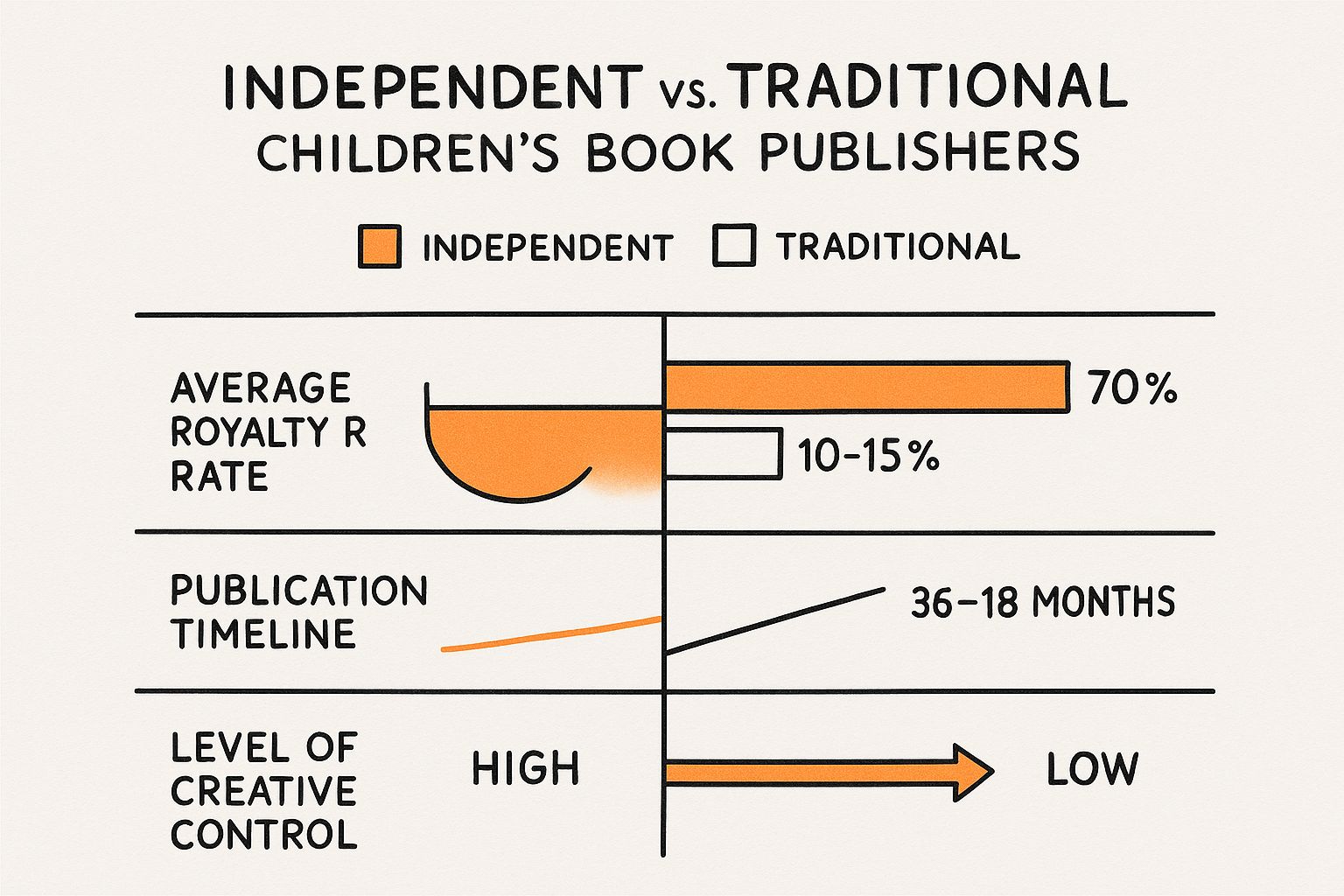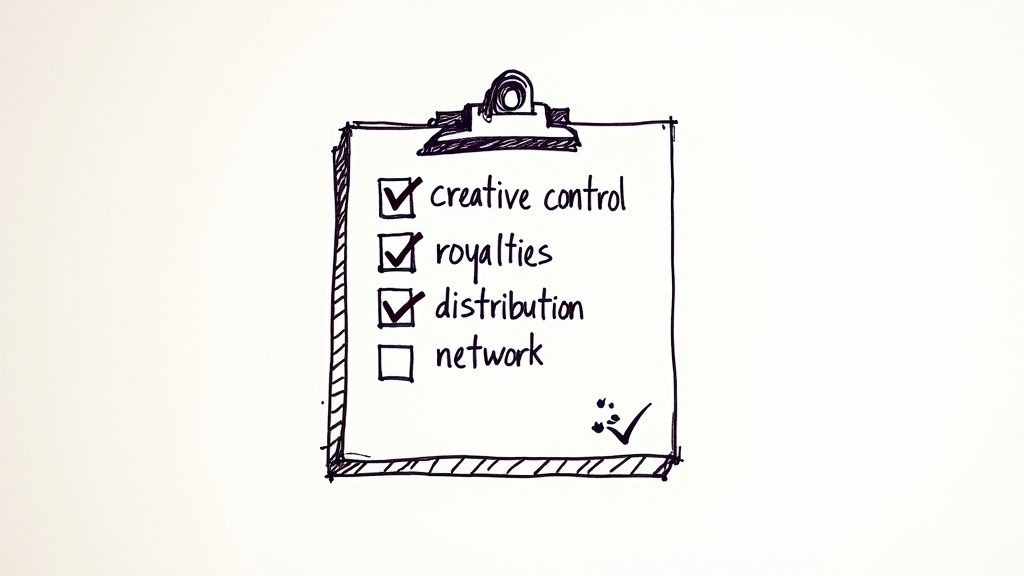Ever wonder where the really unique, quirky, and heartfelt children's books come from? While the big-name publishers have their place, there’s a whole other world of publishing that feels more like a creative workshop than a corporate giant.
These are the independent children's book publishers, and you can think of them as the craft breweries of the book world. They’re smaller, often driven by a specific mission, and they get excited about stories that might not fit the mainstream mold. Because they aren't tied to massive corporate structures, they have the freedom to prioritize a unique vision over what’s currently trending on the bestseller lists.
What Are Independent Children's Book Publishers
Let's stick with that craft brewery analogy for a second. On one hand, you have the huge, global beer brands—they’re consistent, you can find them everywhere, and you know exactly what you’re getting. These are your "Big Five" traditional publishers like Penguin Random House or Simon & Schuster.
Then you have the local microbrewery. The one started by a couple of people who are obsessed with a particular style of beer, experimenting with new flavors and ingredients. That’s your independent children's book publisher.
Their defining feature is their independence; they are not owned by a massive media conglomerate. This single fact shapes their entire philosophy, from the books they choose to the way they work with authors.
Core Traits of an Indie Publisher
Because they're privately owned and can move a lot faster, indie publishers tend to operate with a different playbook. Here’s what often sets them apart:
- Creative Risk-Taking: They’re the ones willing to take a chance on a story that a larger house might consider too niche or unconventional. This is where you'll often find the most innovative artwork and boundary-pushing narratives.
- Mission-Driven Focus: Many indies start with a clear purpose. It could be a passion for amplifying underrepresented voices, a desire to publish books about environmental stewardship, or a commitment to celebrating a certain artistic style.
- Direct Author Collaboration: Forget getting lost in a corporate shuffle. Authors often work directly with a small, dedicated team, making the whole process feel much more personal and hands-on.
It's so important to know the difference between a true independent publisher and a vanity press. A legitimate indie publisher invests in you. They cover the costs of editing, design, and printing because they believe in your book's potential. A vanity press, on the other hand, asks the author to foot the bill. They are fundamentally different models.
To give you a clearer picture, let's look at how the two paths compare for an author.
Independent Publishers vs Traditional Houses at a Glance
Choosing a publisher is a huge decision, and it helps to see the core differences side-by-side. The table below breaks down what you can generally expect from each type of house.
| Characteristic | Independent Children's Book Publishers | Large Traditional Publishers |
|---|---|---|
| Submission Process | Often more accessible; some accept unsolicited manuscripts. | Almost always requires a literary agent. |
| Decision Speed | Faster, with smaller teams making decisions. | Slower, involving multiple committees and departments. |
| Author Advance | Smaller or sometimes non-existent. | Larger, based on projected sales. |
| Royalty Rates | Often higher percentages per book sold. | Typically lower, standardized percentages. |
| Creative Control | More collaborative; authors have greater input. | Less flexible; decisions made by the publisher. |
| Distribution | More targeted; may rely on specialized distributors. | Extensive, with reach into major retail chains. |
| Marketing Support | Grassroots efforts; relies heavily on author participation. | Large, dedicated marketing and publicity teams. |
Ultimately, there isn't a "better" choice—just a different one. The path you take depends entirely on your personal goals as a creator.
This infographic really highlights the trade-offs at play.

As you can see, it comes down to a choice. Traditional houses offer the power of established distribution and big marketing budgets. Indies, however, offer speed, partnership, and a genuine passion for bringing a shared vision to life.
When you work with an independent publisher, you're betting on a team that loves your story as much as you do. They are the true innovation hubs in children's literature, driven by the belief that a good story, no matter how unique, deserves to find its way onto a bookshelf.
The Unique Strengths of Indie Publishing

Choosing to work with an independent children's book publisher is less like a business deal and more like joining a creative family. Their smaller size isn't a weakness—it's actually their greatest strength. It gives them the freedom to move quickly, try new things, and back stories that a larger corporation might dismiss as too niche or risky.
This freedom is a huge win for authors and illustrators. Instead of getting lost in a maze of corporate departments, creators often work side-by-side with the entire publishing team. This hands-on, collaborative spirit keeps the author's original vision at the heart of the project, all the way from the first draft to the final cover.
Passion-Driven Publishing And Marketing
At an independent press, a story is chosen because someone on the team genuinely falls in love with it—not just because it fits a market trend or a sales projection. That raw passion becomes one of their most powerful marketing tools. They don't just sell books; they champion them, because they truly believe in their message.
This personal investment leads to more creative and authentic marketing efforts. Indie publishers are brilliant at:
- Building Niche Communities: They find and connect with specific groups of readers—like families passionate about environmentalism or teachers looking for bilingual books—and build a loyal following.
- Leveraging Author Platforms: They know that an author's personal story is a priceless asset and empower them to become true ambassadors for their own work.
- Focusing on Long-Term Impact: For them, success isn't just about a big launch week. It’s about getting a book into the right hands, where it can be treasured for years to come.
This nimble, heartfelt strategy is proving to be incredibly successful.
Agility, Diversity, and Market Growth
The willingness to take creative risks allows independent children's book publishers to be real trailblazers for diversity and innovation. They're often the first to publish stories that reflect the real lives of underrepresented communities, bringing fresh voices and new perspectives to young readers. If you want to dive deeper into this, you can explore the importance of representation in children's books right here on our blog.
And this focus on unique, necessary stories isn't just a good thing to do—it's good business.
Independent publishers show that you don't need a massive corporate machine to make a huge impact. Their growth comes from a deep understanding of their audience and a commitment to giving them authentic, high-quality books that connect on a personal level.
The numbers don't lie. Between 2019 and 2021, the indie press Microcosm Publishing saw its sales explode by an incredible 207%, making it the fastest-growing independent publisher on the planet. Another indie, Blue Star Press, grew by 120% during that same time. These figures prove that a small, passionate team can make a monumental impact in the world of books.
Navigating the Children's Book Market Landscape
To really get why independent children's book publishers are so important, you first have to understand the playground they're on. The children's book world is a massive, crowded field, and a handful of huge players call most of the shots. Think of it like a harbor where the giant container ships—the "Big Five" publishers—are moving unbelievable amounts of cargo, dictating the main shipping lanes and schedules.
These titans have immense power and influence what you see on the shelves at major retailers. But their sheer size can also make them slow and inflexible. They have to stick with books they know will have guaranteed mass appeal, which inevitably leaves gaps in the market. This is the perfect opening for the smaller, more specialized boats—our indie publishers—to slip through.
The Steady But Challenging Waters
The overall market is pretty stable, but it's not without its challenges. The U.S. children's book industry has seen some modest but consistent growth over the past decade, hitting an estimated $3.5 billion in revenue for 2024. That growth is mostly thanks to a reliable K-12 demographic, but profits are always being squeezed by digital entertainment and changing shopping habits. You can dig into the detailed market stats on IBISWorld to get the full story.
This environment forces everyone to be smart. For the giants, it means playing it safe with proven formulas. For independent children's book publishers, it means finding a totally different way to play the game—one that isn't built on just selling more books.
The modern children's book market isn't a simple David versus Goliath story. It’s a rich ecosystem where different kinds of publishers can thrive by meeting different needs. The secret for indies isn't to outsell the giants, but to out-serve specific, passionate communities.
Finding Opportunity in the Gaps
This is exactly where indie publishers find their footing and really start to shine. Rather than fighting for that limited mainstream shelf space, they succeed by focusing on the readers that the major publishers often overlook. They build their whole business around filling those specific needs.
Here's how they do it:
- Focusing on Niche Audiences: An indie might build its entire catalog around books celebrating neurodiversity, telling bilingual stories, or sharing tales rooted in a specific cultural heritage.
- Championing Unconventional Genres: They're the ones willing to take a chance on that beautifully poetic, art-forward picture book or a middle-grade novel that breaks all the genre rules.
- Serving Underserved Communities: They make it their mission to find and publish stories that act as mirrors for kids who almost never get to see themselves in the books at the big stores.
By sailing in these less crowded waters, independent publishers forge deep, lasting connections with their readers. They prove that in a packed market, winning isn't always about being the biggest ship. Sometimes, it’s about being the most agile one with the clearest destination.
How to Find and Approach the Right Indie Publisher

Once your manuscript is polished and ready, the real treasure hunt begins: finding the perfect home for your story. When it comes to independent children's book publishers, this isn’t about casting a wide net and hoping for the best. It’s about precision.
Think of yourself as a literary matchmaker. Your mission is to find that one special publisher whose catalog and mission feel like they were made for your manuscript. This takes a bit more than a quick Google search; it's an active, hands-on investigation to pinpoint the presses that will truly get—and champion—your work.
Building Your Targeted Publisher List
A generic, blast-it-out-everywhere submission is an ignored submission. Instead, put on your detective hat and use these strategies to uncover the absolute best matches for your book.
- Bookstore Reconnaissance: Spend an afternoon in the children's section of your favorite independent bookstore. Look for books that have a similar tone, art style, or heart to your own story. Flip to the copyright page and jot down the publisher's name. This is one of the most organic ways to find active, successful indies.
- Tap Into Industry Resources: Get your hands on guides like the Children's Writer's & Illustrator's Market (CWIM) or join communities like the Society of Children's Book Writers and Illustrators (SCBWI). These are goldmines for publisher directories, market news, and inside scoops on who is looking for new work.
- Social Media Sleuthing: Follow agents, editors, and indie publishers on platforms like X (formerly Twitter) and Instagram. Editors often use the hashtag #MSWL (Manuscript Wish List) to share exactly what they’re hoping to find, giving you a direct line into their current needs.
The global children's book market isn't just growing; it's becoming wonderfully diverse. In 2022, children's books accounted for about 10% of all new titles worldwide. Even more exciting, there's been a 20% jump in both bilingual and translated books over the last three years, opening up incredible new avenues for authors with unique cultural stories. To get a broader view of these trends, you can explore more children's book sales statistics.
Crafting a Submission That Stands Out
With your highly-curated list in hand, it’s time to make your introduction. Following each publisher's unique submission guidelines isn’t just a suggestion—it's non-negotiable.
Some presses are wide open to unagented submissions, while others have very specific windows or requirements. For a head start, you can check out our list of children's book publishers that accept unsolicited manuscripts.
Your submission package has to be both professional and personal. Take the time to tailor your query letter to each publisher. Explain exactly why your story is a perfect fit for their specific catalog. Even better, mention a book they published that you genuinely admire. This small, thoughtful detail proves you’ve done your homework and respect their work, instantly setting you apart from the crowd.
Preparing a Manuscript That Gets Noticed

Having a fantastic story idea is wonderful, but it's really just the first step. To have any hope of catching the eye of independent children's book publishers, your manuscript has to be professional, clean, and basically ready to go.
Sending in a rough first draft is a bit like showing up to a job interview in your pajamas. It tells the editor you aren't taking this seriously and that you don't respect their time. You have to think of your manuscript as a product you're trying to sell, and it needs a solid round of quality control before anyone else lays eyes on it.
Getting Feedback to Refine Your Story
It's nearly impossible for any writer to see all the weak spots in their own work. We’re just too close to it. That's why getting fresh eyes on your story isn't just a good idea—it's essential.
You'll want to build a small, trusted circle of readers to give you honest feedback. This team should ideally include:
- Critique Partners: These are other writers who get the nuts and bolts of storytelling. They can give you specific, craft-based feedback on things like pacing, character development, and whether your dialogue sounds natural.
- Beta Readers: Think of these folks as your test audience. They aren't necessarily writers, but they love to read. They can tell you if a joke actually made them laugh, if a plot twist surprised them, or if they connected with your main character.
Presenting a polished, professional manuscript signals that you are a dedicated creator who respects the publisher's time. It shows you are ready for a collaborative partnership and have already invested the hard work needed to make your story shine.
Mastering Manuscript Formatting
After you've incorporated feedback and the story itself feels solid, the last step is formatting. Every publisher will have slightly different submission guidelines, but sticking to general industry standards makes an editor's job much easier. A clean, readable document always makes a better first impression.
For picture books, this often means understanding the standard 32-page structure. It's a format that librarians, booksellers, and publishers all know and expect.
Taking the time to get these details right does more than just look good. It shows you’re a professional who's serious about their craft, ready to work with a publisher to bring a truly great book to life.
Spotlighting Innovative Independent Publishers
The best way to really get a feel for the independent publishing world is to see it in action. Talk is cheap, right? So let’s look at a few standout presses who are living out their missions and creating beautiful, memorable books.
Each one has carved out its own unique space by backing stories that truly matter. For authors and illustrators, seeing what they do is incredibly inspiring. It proves there’s a home for every kind of story, whether it’s a tale celebrating global cultures or one that completely redefines what a picture book can be.
Barefoot Books
For over 30 years, Barefoot Books has been leading the charge in creating stories that champion diversity, inclusion, and a sense of global community. Their whole reason for being is to open children’s hearts, minds, and worlds. They have a fierce commitment to publishing books that are both "mirrors and windows"—letting kids see themselves in a story while also peering into the lives of others.
You can feel their mission the moment you see their work. The screenshot of their homepage below just screams joy, vibrancy, and cultural richness.
This visual-first approach, bursting with color and showing children from all walks of life, is the perfect reflection of their promise to nurture curiosity and compassion in young readers.
Flying Eye Books
Flying Eye Books is the children's imprint of Nobrow Press, and it definitely inherited the family's obsession with incredible art and design. These aren't just books; they're a feast for the eyes. Their entire catalog is a masterclass in visual storytelling, where the illustration isn't just supporting the text—it is the main event.
From richly detailed non-fiction about the animal kingdom to quirky, imaginative narratives, you know a Flying Eye book when you see one. They attract some of the most talented illustrators from all over the world and give them the creative freedom to do what they do best. For creators who see themselves as artists first and foremost, Flying Eye is a dream come true.
Chronicle Books Kids
Chronicle Books is a bigger player in the independent scene, but its children's division has all the creative energy and quick-on-its-feet spirit of a much smaller press. They’ve built an amazing reputation for publishing books that are clever, funny, and often interactive. Think of groundbreaking titles like Press Here by Hervé Tullet, which turns the book itself into a toy.
Chronicle Books Kids excels at creating books that are not just read but experienced. They understand that play is a powerful form of learning and have built a beloved brand around titles that spark interaction, laughter, and surprise.
Their success proves that independent children's book publishers can hit the big time commercially without watering down their innovative spirit. If you're an aspiring author trying to find the right fit, studying the catalogs of presses like these is one of the best things you can do. For more pointers, our guide on the best publishers for new authors can give you some extra direction.
Ultimately, these publishers show that having a strong, unique vision isn't just a nice idea—it's the key to making a real mark.
Burning Questions About Indie Publishing
Dipping your toes into the world of independent children's book publishing can feel like stepping into a whole new country. It’s exciting, but you’ve probably got a ton of practical questions about how things actually work. Getting those questions answered is the key to figuring out if this path is the right one for your book and your career. Let's dig into some of the most common ones.
What’s the Deal with Advances and Royalties?
This is the big money question, right? With indie publishers, you'll generally see smaller advances than what the giant houses might offer—think anywhere from a few hundred to a few thousand dollars. Sometimes, there's no advance at all.
But here's the trade-off: indie presses often balance this with higher royalty rates. They're betting on the long-term success of the book, giving you a bigger piece of the pie as it sells. It’s a partnership model, really, built on a shared belief in the story. Every contract is different, though, so always read the fine print.
So, Is It Easier to Get a Book Deal?
Not really easier, just different. An independent children's book publisher might not get the same mountain of submissions as a Big Five imprint, but that doesn't mean they aren't picky. In fact, they can be incredibly selective.
Your best shot isn't just about writing a good book; it's about finding the perfect home for it. A manuscript that aligns perfectly with an indie's unique mission has a much better chance of getting a serious look than a generic submission blasted out to everyone.
How Much Marketing Will I Have to Do?
Plan on rolling up your sleeves and becoming your book's biggest cheerleader. Indie publishers count on their authors to be active partners in spreading the word. You’ll be the one hitting up local events, firing up your social media, and connecting with your community.
If you're an author who genuinely loves connecting with readers and isn't afraid to get hands-on with promotion, you'll fit right in. It’s a true team effort to get your story out there and into the hands of kids who need it.
At Number 6 Publishing, we believe every great story deserves a chance to be read. We are dedicated to finding and championing the underdog authors and illustrators who bring heart and imagination to young readers. Discover a new favorite story by exploring our curated catalog of middle grade and YA titles.
